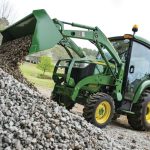Bulldozers are heavy equipment capable of moving heavy loads, clearing rubble, and are very helpful in civil engineering works. Modern bulldozers are no uglier and too heavy to handle. They are equipped with electronic devices and they look good, too.
The word “bulldozer” is normally inferred to indicate heavy equipment, like a loader or an excavator, but specifically it signifies a tractor fitted with a blade.

A bulldozer is a tracked tractor that has an integral metal blade used to drive a significant magnitude of soil, sand, debris, etc., generated during construction. Generally, bulldozers are huge and robust tracked equipment. The tracks provide exceptional ground grip, and mobility in patchy terrain. The bulldozer weight is distributed by the wide tracks over vast area. Thus, the pressure applied is decreased, and the bulldozer is prevented from plunging in sandy ground. Bulldozers have a torque divider that is designed to transform the engine power into enhanced dragging capability.
The bulldozers can tow heavy tanks with ease. Due to these characteristics, bulldozers are employed to remove debris, obstacles, clear roads, bushes, and trees. Bulldozers can also be used to dig trenches, farming works, and even military operations.
Major Components of a Bulldozer
The major components of a bulldozer are the blade and the ripper. The ripper can be identified as the extended device at the bulldozer rear. Rippers contain only one shank, or can be in groupings of two or more that are called as multiple shank rippers. Generally, single shank rippers are chosen for deep ripping. Hard earth is broken in ripping for agricultural purposes.
Even lava can be crushed by heavy bulldozers to allow agriculture. Also, other hard soils can be ripped to permit planting of orchards in land where otherwise trees could not grow. The second major component of a bulldozer is the blade, which is the heavy metal plate at the front. It is used to shove objects, soil, sand, and debris.
Some bulldozers are modified by replacing the blade with a large bucket and hydraulic arms that are used for lifting and lowering of the bucket. Loader tractors are created, thus making the bulldozer valuable for soil excavation, and loading the soil into trucks.
Other functions of bulldozers are for deforestation, earth removal, and ground flattening. Heavy bulldozers are generally engaged for terrain leveling to organize it for construction. The construction is mostly executed by the use of small bulldozers. Broadly we can categorize bulldozers based on the following factors.
Type of Blade
Different bulldozers use different types of blades and depending upon the type of blade used, bulldozers are used at different construction sites. For grading of surface and evening of soil, straight blade bulldozers are most useful. Another type uses a U blade, which is also called a universal blade.
It is best suited for pushing, hauling, and scooping works. However, one cannot use straight blade bulldozers or U blade bulldozers for very heavy works, and it will require working with a combination blade. Combination blade bulldozers can do petty jobs like pushing and cleaning debris and also work with heavy loads at the same time.
Hybrid Bulldozers
Hybrid bulldozers are advanced equipment making use of electronic components and are equipped with a combination of blades that can work in water logged and very hard conditions simultaneously. Today we have bulldozers that can work even in swampy conditions. We have customized blades too that can be mounted over any type of vehicle like a tractor, all-terrain vehicles, and skid steers.
Mobility Factors
Based on mobility, track and tire bulldozers are the two major types of bulldozers. A tire bulldozer will have better mobility and are light in weight. However they cannot perform heavy lifting tasks as compared to track bulldozers, which is the second type of bulldozers based upon their mobility. Track bulldozers are suitable for hard surfaces as they can damage the soft surface. For hauling purposes, track bulldozers are suitable, whereas for leveling and moving materials, a tire bulldozer is the best option.
Modifications in bulldozer design are continuously being performed to fulfill the changing requirements of bulldozer functions. The major modifications have been performed for the cab comfort and the efficiency of the diesel engine. The bulldozer capability to work effectively has been restricted by the traction transferred to the tractor treads. Bulldozers have been improved by the incorporation of a reciprocating blade that can outclass the heavy bulldozers. The blade is designed to produce telescoping movements.
These bulldozers are light, and can perform similar functions by virtue of the blade reciprocating movement. The reciprocating blade provides an alternating pulsing blade action on the object. Thus, the improvement has created a smaller bulldozer, with the characteristics of a considerably bigger machine. Hydraulic arms, improved drive trains, and powerful engines have increased the efficiency of bulldozers as well, relatively making them fast moving equipment.


